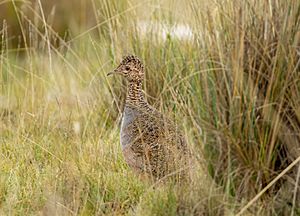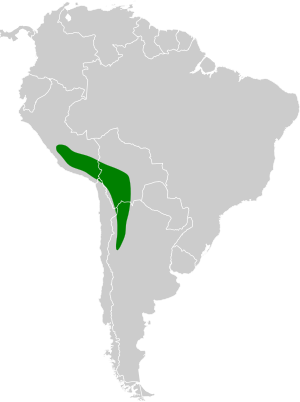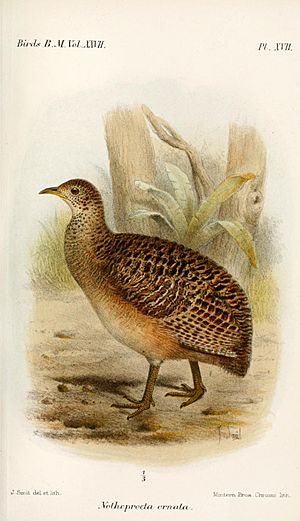Ornate tinamou facts for kids
Quick facts for kids Ornate tinamou |
|
|---|---|
 |
|
| N. ornata observed in Peru | |
| Conservation status | |
| Scientific classification | |
| Genus: |
Nothoprocta
|
| Species: |
ornata
|
| Subspecies | |
|
N. o. ornata |
|
 |
|
| Synonyms | |
|
Nothoprocta kalinowskii |
|
The ornate tinamou (Nothoprocta ornata) is a special type of bird found in the high mountains and dry bushy areas of west-central South America. These birds are known for their unique appearance and how they live in their environment.
Contents
What's in a Name?
The name Nothoprocta comes from two ancient Greek words. Nothos means 'fake' or 'counterfeit,' and prōktos means 'hindpart' or 'tail.'
Scientists think this name refers to how the tinamou's tail is hidden. It's tucked away behind its body feathers, making it hard to see.
Bird Family Tree
All tinamous belong to the bird family called Tinamidae. They are also part of a larger group of birds known as ratites. Other ratites include ostriches, emus, and rheas.
Unlike most other ratites, tinamous can fly. However, they are not very strong fliers. Scientists believe all ratites evolved from birds that could fly a long time ago. Tinamous are the closest living relatives to these ancient flying birds.
Different Types of Ornate Tinamous
For a while, another bird called Kalinowski's tinamou (Nothoprocta kalinowskii) was thought to be a separate species. But after more research, scientists realized it was the same as Nothoprocta ornata branickii.
The American Ornithologists' Union (SACC) officially agreed with this change in 2007. This means Kalinowski's tinamou is now considered a subspecies of the ornate tinamou.
The ornate tinamou has three different subspecies:
- N. o. ornata: This type lives in the Andes mountains. You can find it in southeastern Peru, the very north of Chile, and western Bolivia.
- N. o. branickii: This subspecies lives in the puna region of central Peru. This includes areas like Ancash, Lima, Ica, Junín, Ayacucho, Huancavelica, and Apurímac.
- N. o. rostrata: This one is found in the Andes of northwestern Argentina. Specifically, it lives in the Jujuy and La Rioja Provinces.
What Does it Look Like?
The ornate tinamou is about 32 cm (13 in) long. Its upper body is brownish-grey with black and buff marks. Its underside is a tawny-buff color with darker stripes.
Its head and neck are buff-colored and have clear black spots. The bird has a thin, curved beak. Its legs can be either yellow or grey.
Life and Habits
Like other tinamous, the ornate tinamou mostly eats fruit. They find fruit on the ground or on low bushes. They also eat small amounts of insects, flower buds, soft leaves, seeds, and roots.
Reproduction and Family Life
When it comes to raising young, the male ornate tinamou does most of the work. He incubates the eggs, which can come from as many as four different females.
After the eggs hatch, the male raises the chicks. They usually stay with him for about two to three weeks until they are ready to live on their own. The nest is built on the ground, often hidden in thick bushes or between large roots.
Where it Lives
This bird is native to the puna region of central Peru. It also lives in the Andes mountains. You can find it in southeastern Peru, western Bolivia, the far north of Chile, and northwestern Argentina.
Its Home Environment
The ornate tinamou prefers to live in high-altitude grasslands. They also live in shrublands, both high and low in elevation. These birds have even started to adapt to living on farmlands.
They usually live at elevations between 3,450 to 4,700 m (11,320–15,420 ft).
Protecting the Species
The IUCN (International Union for Conservation of Nature) lists the ornate tinamou as a species of Least Concern. This means their population is stable and not currently at risk.
Their habitat covers a large area, about 740,000 km2 (290,000 sq mi).
See also
 In Spanish: Perdiz cordillerana para niños
In Spanish: Perdiz cordillerana para niños



